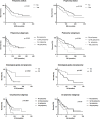1p and/or 19q polysomy is an adverse prognostic factor in oligodendrogliomas, and easy to detect by automated FISH
- PMID: 40315229
- PMCID: PMC12047829
- DOI: 10.1371/journal.pone.0322809
1p and/or 19q polysomy is an adverse prognostic factor in oligodendrogliomas, and easy to detect by automated FISH
Abstract
Objective: To study the feasibility of automated analysis by FISH technique in the determination of the 1p and/or 19q polysomy in oligodendrogliomas (OGs) and to explore its prognostic value.
Methods: We analyzed a retrospective monocentric series of 145 consecutive OGs with IDH mutation and 1p/19q codeletion. For all cases, automated FISH analyses were performed to determine 1p and/or 19q polysomy status and results were compared to manual analysis to verify the concordance of the two methods. Polysomic status was then compared to clinical and histological data, the CDKN2A deletion status when available, event free survival (EFS) and overall survival (OS).
Results: Our study comprised 79 grade 2 OGs (O2) and 66 grade 3 OGs (O3). Polysomy of 1p and/or 19q was observed in 58 cases (40% of whole cohort) with a significant enrichment in the high grade cohort (59% versus 24%; p < 0,0001) and recurrent cases (55%). A majority of polysomic cases were copolysomic for 1p and 19q (75% of the polysomic cohort) rather than 1p or 19q single polysomy (21% and 4% respectively). Polysomy was correlated to high grade histological criteria of high mitotic and Mib1 proliferative indices (p = 0,002 and p = 0,0005 respectively) and to vascular proliferation (p = 0,0003). Univariate and multivariate analysis showed a significant correlation betwen polysomy and a shorter EFS and OS (p = 0,02 and p = 0,016 respectively). Concordance between manual and automated analysis was almost perfect for both 1p and 19q analysis (96 and 98% respectively, κ = 0,92 and 0,95 respectively). Automated analysis revealed that the large majority of polysomic signatures are represented by a small number of R/G signals (mainly 7 signatures) allowing a very easy implementation to pre-existent FISH platforms analysis software.
Conclusion: 1p and/ or 19q polysomy status represent a prognostic factor in OGs and can be easily determined by automated analysis. Our study supports the clinical interest to determine the polysomic status in all primitive or recurrent OGs and underline the benefits of automated analysis which offers a better archive storage and facilitates multicentric comparison.
Copyright: © 2025 Michaud et al. This is an open access article distributed under the terms of the Creative Commons Attribution License, which permits unrestricted use, distribution, and reproduction in any medium, provided the original author and source are credited.
Conflict of interest statement
The authors have declared that no competing interests exist.
Figures





Similar articles
-
Polysomy is associated with poor outcome in 1p/19q codeleted oligodendroglial tumors.Neuro Oncol. 2019 Sep 6;21(9):1164-1174. doi: 10.1093/neuonc/noz098. Neuro Oncol. 2019. PMID: 31140557 Free PMC article.
-
Contribution of 1p, 19q, 9p and 10q Automated Analysis by FISH to the Diagnosis and Prognosis of Oligodendroglial Tumors According to WHO 2016 Guidelines.PLoS One. 2016 Dec 28;11(12):e0168728. doi: 10.1371/journal.pone.0168728. eCollection 2016. PLoS One. 2016. PMID: 28030632 Free PMC article.
-
Polysomy for chromosomes 1 and 19 predicts earlier recurrence in anaplastic oligodendrogliomas with concurrent 1p/19q loss.Clin Cancer Res. 2009 Oct 15;15(20):6430-7. doi: 10.1158/1078-0432.CCR-09-0867. Epub 2009 Oct 6. Clin Cancer Res. 2009. PMID: 19808867 Free PMC article.
-
Co-polysomy of chromosome 1q and 19p predicts worse prognosis in 1p/19q codeleted oligodendroglial tumors: FISH analysis of 148 consecutive cases.Neuro Oncol. 2013 Sep;15(9):1244-50. doi: 10.1093/neuonc/not092. Epub 2013 Jul 16. Neuro Oncol. 2013. PMID: 23861470 Free PMC article.
-
Polysomy of chromosomes 1 and/or 19 is common and associated with less favorable clinical outcome in oligodendrogliomas: fluorescent in situ hybridization analysis of 84 consecutive cases.J Neuropathol Exp Neurol. 2012 Jul;71(7):618-24. doi: 10.1097/NEN.0b013e31825b5f7a. J Neuropathol Exp Neurol. 2012. PMID: 22710961
References
-
- WHO Classification of Tumours Editorial Board. Central nervous system tumours. Lyon (France): International Agency for Research on Cancer; 2021. WHO classification of tumours series, 5th ed.; vol.6:28–38.
-
- Jenkins RB, Blair H, Ballman KV, Giannini C, Arusell RM, Law M, et al.. A t(1;19)(q10;p10) mediates the combined deletions of 1p and 19q and predicts a better prognosis of patients with oligodendroglioma. Cancer Res. 2006;66:(20):9852–61. - PubMed
MeSH terms
LinkOut - more resources
Full Text Sources
Medical
Miscellaneous

